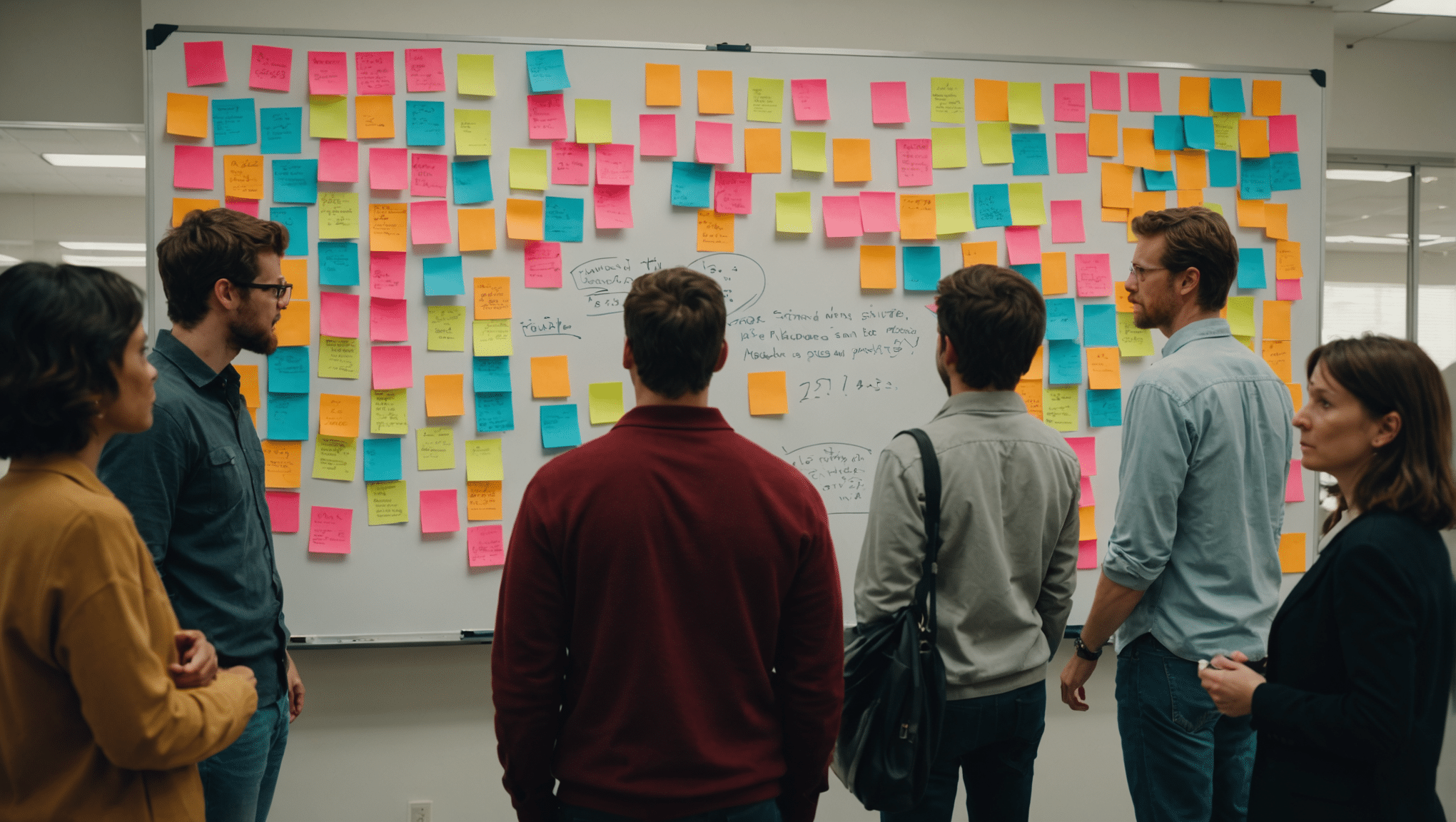
Powerful Post-it Note Brainstorming Method: Boost Creativity and Collaboration
Ready to BOOST your brainstorming? Use the simple and FLEXIBLE Post-it Note Brainstorming Method to VISUALLY organise ideas and solve problems with sticky notes.
Last Updated on 06/10/2025
Post-it notes are an effective tool for visual brainstorming, making it easy to map out ideas and organise thoughts in a flexible, dynamic way. By using them, individuals or teams can see connections clearly, quickly rearrange concepts, and develop creative solutions that foster better problem-solving and collaboration.
How do I use Post-it notes for brainstorming?
To brainstorm with Post-it notes, write one idea per note, then arrange and group the notes on a surface. This method helps visualise connections, organise thoughts, and encourage collaboration, making it easy to generate and refine ideas during individual or group sessions.
Essential Tips for Post-it Note Brainstorming
- Write one idea per sticky note to keep things clear and focused.
- Encourage all participants to contribute their thoughts without interruptions during the session.
- Use a large surface, like a wall or board, to visualise connections between ideas.
- Group sticky notes by related concepts to spot patterns or gaps.
- Rearrange or remove irrelevant notes to refine the brainstorming process.
- Ask open-ended questions to stimulate new ideas and deepen discussions.

Collaborative Techniques for Problem Solving
When brainstorming in a group, Post-it notes are a great way to ensure everyone’s ideas are heard. By writing down each idea on a sticky note, every participant can contribute to the conversation without interrupting others. This technique makes it easier to capture a wide range of thoughts and perspectives.
Once the ideas are collected, the real magic happens. Participants can physically move the notes around, grouping similar concepts or even generating new ideas by combining them. This flexibility allows for a dynamic and engaging session where ideas flow freely, helping the team solve problems creatively.
Post-it notes also help keep everyone on the same page, especially when working towards a specific goal. By visually organizing thoughts, participants can quickly spot connections between ideas that might not have been obvious before.
Part 1: Visualise and Organise Ideas Efficiently
Visualising ideas is key when trying to solve problems efficiently. With Post-it notes, you can easily transform abstract thoughts into tangible paper notes that grab attention. By sticking them to a wall or board, it’s simple to organise your thoughts in a way that helps you make sense of the bigger picture.
Using this technique, you can move the notes around, visually mapping out the relationships between ideas. One idea might spark a whole chain of thoughts, allowing you to generate fresh solutions. This method helps you organise complex topics into manageable parts and is especially helpful in early brainstorming stages.
The best part? It’s totally flexible. You can change the order of your notes or remove irrelevant ones without having to rewrite anything. If you’re feeling stuck, grab a pen and sticky note and start generating ideas. You’ll be amazed at how it jumpstarts your creative process.
Part 2: Execute the Brainstorming Process
To make the most of your brainstorming session, execution is key. Start by setting a clear goal for the group. Whether it’s to solve a specific problem or generate ideas, knowing your goal helps keep the session focused. Hand out sticky notes and pens to each participant, and let everyone write down their thoughts.
Once you’ve collected the notes, it’s time to get to work. Start organizing them on a surface, grouping similar ideas together. Encourage the team to ask questions about why certain ideas were placed in certain groups, sparking more creativity. This is when the technique really shines, giving everyone a chance to contribute.
After the ideas are organised, it’s time to take action. Identify the top concepts and start developing concrete plans. This method not only helps you visualise problems but also creates a clear path forward. You’ve gone from brainstorming to executing in no time, all thanks to a few pieces of sticky paper!
| Step | Description | Importance |
|---|---|---|
| Idea Generation | Write down one idea per sticky note. | High |
| Organizing Ideas | Group similar ideas for better structure. | Medium |
| Visualization | Arrange notes on a wall or board to see connections. | High |
| Problem Solving | Move and combine notes to develop solutions. | High |
Solving Complex Problems with Post-it Notes
When faced with a big problem, breaking it down into smaller parts is often the best way to tackle it. With Post-it notes, you can write down each part of the problem and begin solving it piece by piece. This approach helps prevent you from feeling overwhelmed by the entire issue.
Once you have all the parts written down, you can move the notes around to visualise potential solutions. By testing out different combinations of ideas, you might uncover answers that weren’t immediately obvious. The flexibility of sticky notes lets you see the problem from multiple angles without any commitment to a single solution.
As you experiment with different ideas, you’ll find that this method helps create a clear strategy for solving even the most complex problems. When you can physically see the steps in front of you, it’s easier to connect the dots and create actionable solutions.
Advanced Techniques to Visualise Success
One gap in many brainstorming methods is the lack of advanced techniques to visualise long-term success. Using Post-it notes, you can create not only basic idea clusters but also advanced mind maps. These maps help you plan out the different phases of a project, showing how ideas evolve over time.
This technique can also be used to create visual timelines. Writing key milestones on sticky notes allows you to shift around your plans based on priority and deadlines. This flexibility lets you adapt your strategy as needed, keeping your project on track. It’s like giving your ideas a roadmap to success.
Advanced Post-it note techniques are ideal for those looking to go beyond basic brainstorming and execute ideas with precision. Whether you’re visualizing success with mind maps or planning a project timeline, these methods offer an organised, efficient way to stay ahead of the game.
Conclusion
The Post-it note brainstorming method is a simple yet powerful tool for generating ideas, organizing thoughts, and solving problems. Its flexibility allows teams to collaborate effectively, visualise solutions, and execute plans with ease, making it perfect for any workplace environment.
At Viking, we are passionate about workplace solutions that boost productivity while keeping costs down. Whether you’re leading a brainstorming session or looking for tools to improve collaboration, our range of products will help you create the ideal workspace that meets your needs.
Frequently Asked Questions
What is the Post-it note brainstorming method?
The Post-it note brainstorming method involves writing ideas on individual sticky notes and arranging them on a surface to generate ideas and solve problems. It is a flexible technique that helps participants visualise connections and organise thoughts, making it easier to brainstorm both individually and collaboratively.
How do I run an effective brainstorming session with Post-it notes?
To run a successful session, give each participant sticky notes and a pen. Ask them to write down one idea per note. Once ideas are collected, arrange them on a surface, grouping similar concepts. This method helps organise ideas and fosters productive conversations, focusing attention on each concept.
How does Post-it note brainstorming help solve problems?
This method helps break down complex problems into smaller parts by writing key points on sticky notes. By visually arranging the notes, participants can explore connections between ideas and generate creative solutions. It’s a hands-on, effective way to organise information and see problems from new angles.
Can Post-it notes be reused for multiple brainstorming sessions?
While sticky notes can be reused, they are designed for single-session brainstorming due to their adhesive. Over time, the stickiness fades, reducing their effectiveness. For long-term brainstorming projects, consider using new Post-it notes to ensure ideas remain visible and well-organised without losing attention.









